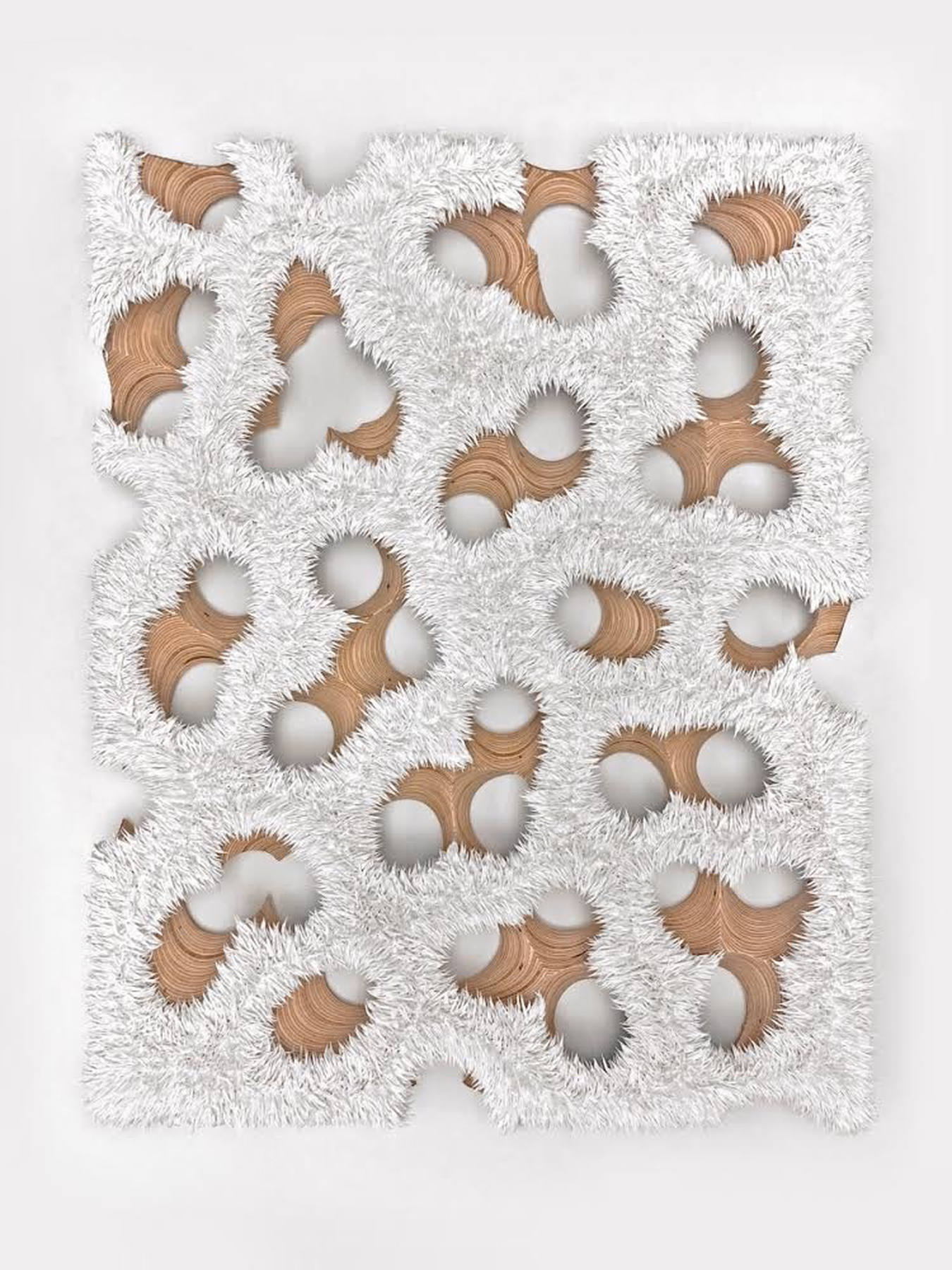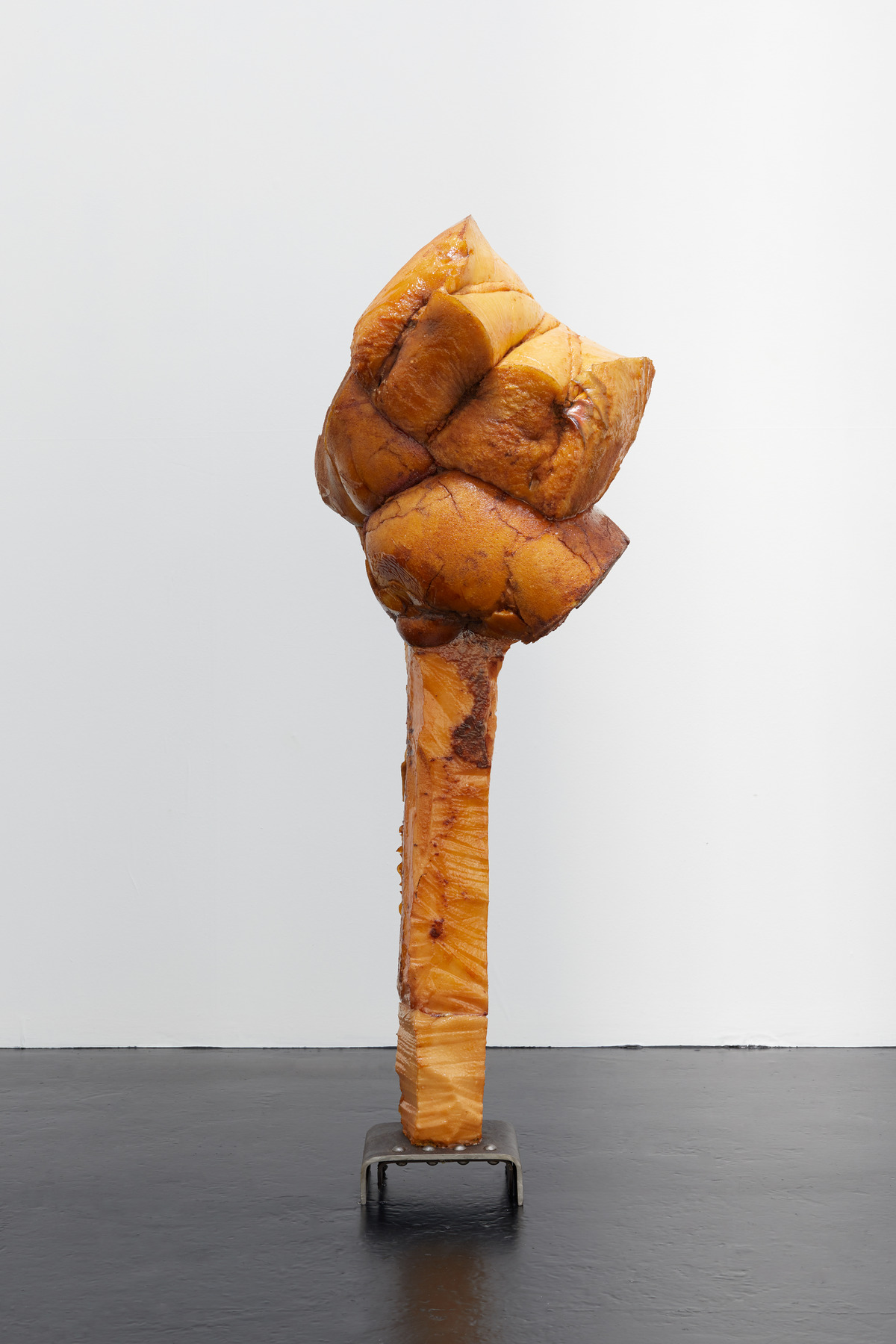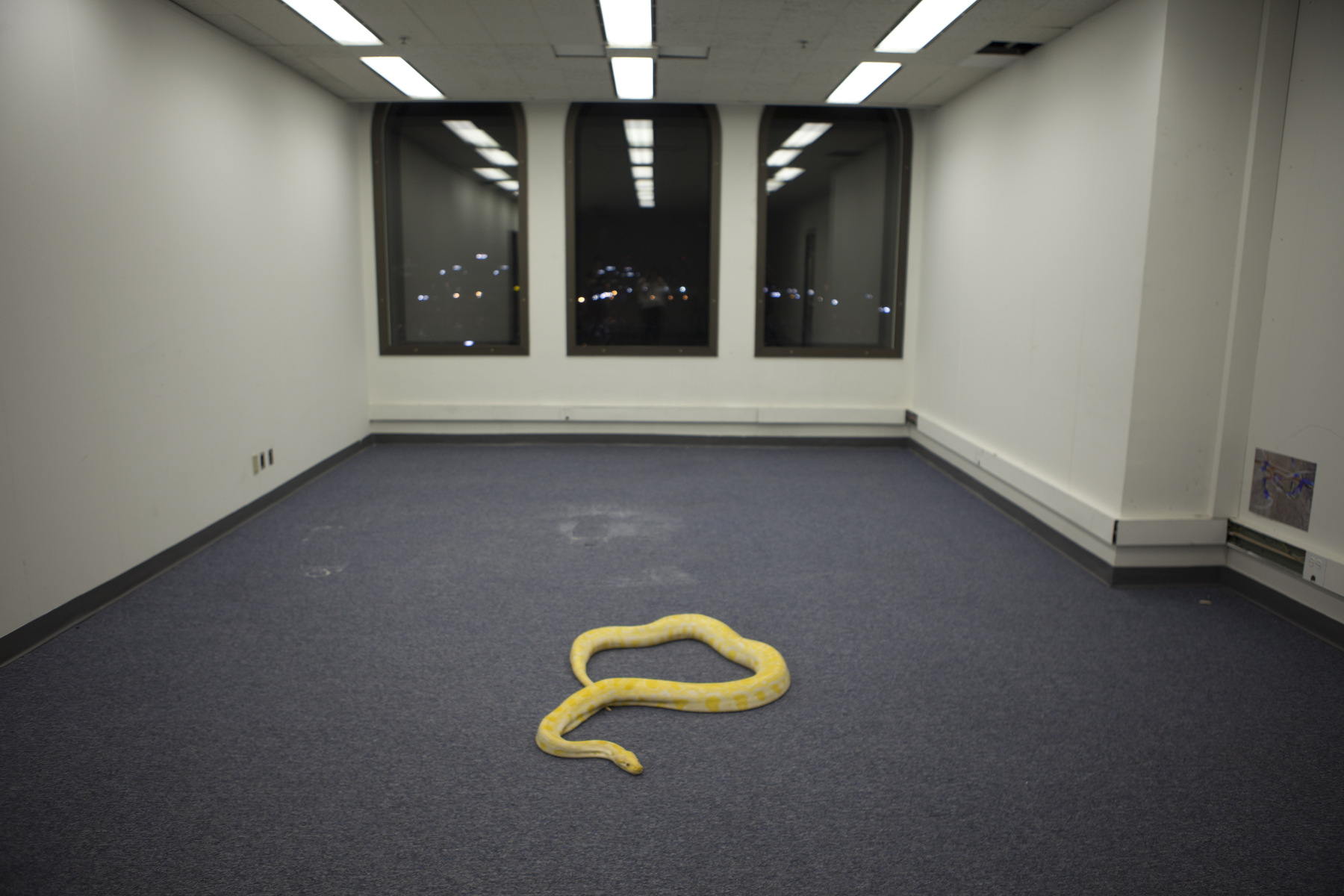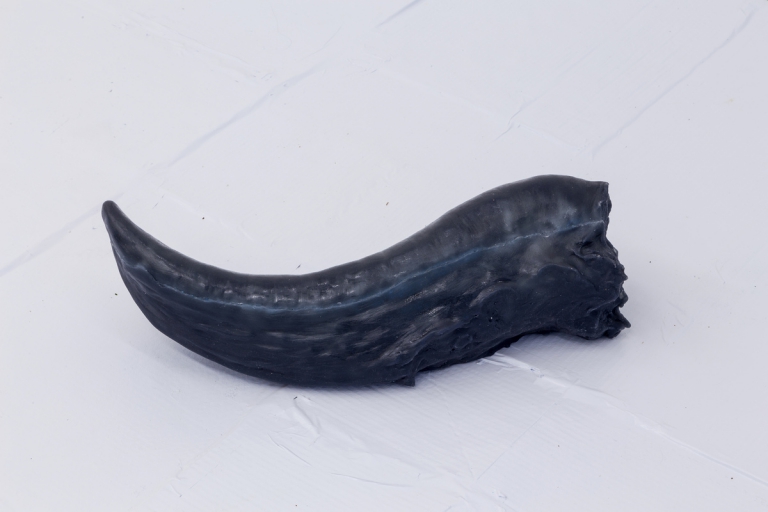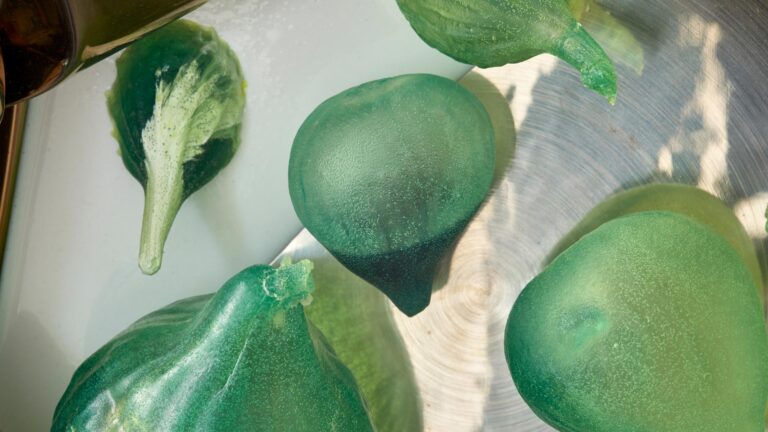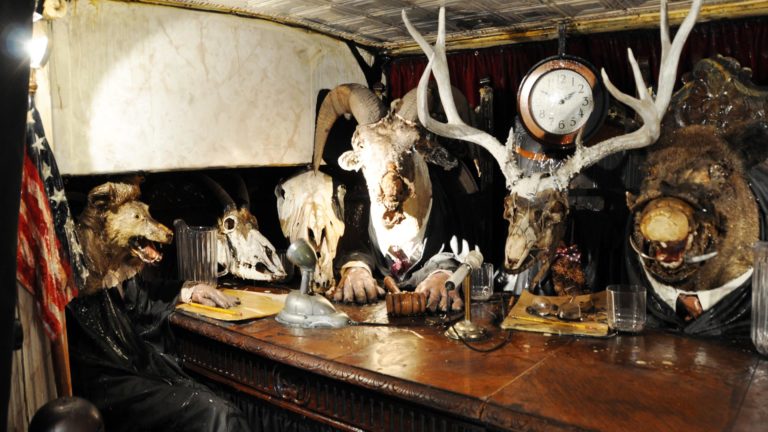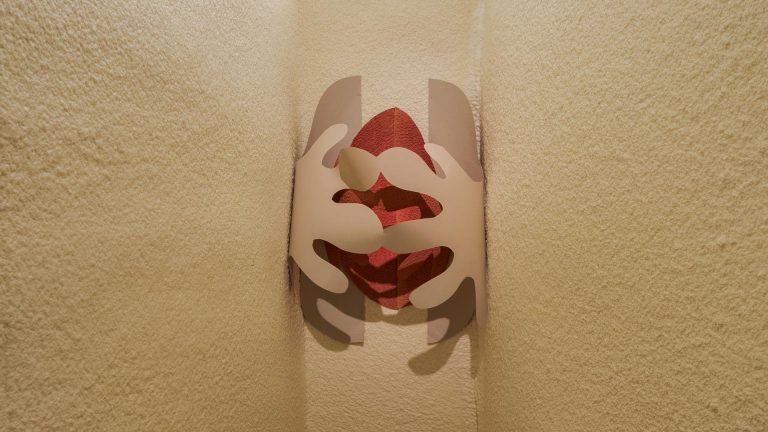Artists: Lutz Bacher, Lynda Benglis, Ernesto Caivano, James Crosby, Olivia Erlanger, Ryan Estep, John Gerrard, Elias Hansen, Max Hooper Schneider, Shaun Krupa, Helmut Lang, Kris
Lemsalu, Sherrie Levine, Lila de Magalhaes, Donald Moffett, David Seth Moltz, Dominic Nurre, Holt Quentel, Pilar Quinteros, Lauren Satlowski, Oscar Tuazon, Thaddeus Wolfe, Phillip Zach
Exhibition title: Wormwood
Organised by: Todd von Ammon
Venue: Ellis King, Dublin, Ireland
Date: July 7 – August 12, 2017
Photography: all images copyright and courtesy of the artist and Ellis King, Dublin
Wormwood’s first layer is simply the word itself—wood qualified with worm. First, the worm itself: there’s a fantastic non-translatable word in German, durchschlängeln which translates roughly as, “to worm one’s way through”—or as the case may be, to survive via some form of linear (often digestion-like) struggle (the worm chandeliers of Thaddeus Wolfe; the ghostly crawlers of Phillip Zach). Adjacent in many cases to the worm in this show is the artwork full of holes—some cavities made organically by worms, others made through tearing, drilling or chewing (the metaphoric knot paintings of Sherrie Levine; the chewed up tarpaulins of Holt Quentel; the burnt-out tapestries of Lila de Magalhaes; the literally worm-eaten wood panels by Eli Hansen and Oscar Tuazon). Other works represent vomit or excrement (the half-digested morsels embedded in Kris Lemsalu’s ceramics; the erect, fecal totems of Helmut Lang; the peeled skin forms of Lynda Benglis’ ceramics)—whatever the worm casts away in its indifferent pursuit of more life.
The second layer is one that defies simple notions of inner and outer space: Artemisia absinthium (absinth wormwood) is a plant whose ancient service to humanity was as an anti parasite [1] —literally a wood that killed worms in the digestive tract. References to sickness and antiseptics find themselves as a dichotomy between Ryan Estep’s slippery and precarious antibacterial soap balls throughout the room versus the pestilent sculpture by James Crosby of a body overwhelmed by metastatic disease. The curatively toxic properties of artimisia found macrocosmic context in the book of revelation: the Wormwood Star—inverted from its use in the human gut—poisons one third of the earth’s waters as worldly existence comes to a close. This inverted, astral body finds shape in Ernesto Caivano’s ethereal works on paper, which confound the normally distinctive spaces of the cellular versus the intergalactic—his ongoing nocturnes series based on of the visual parity between the optic nerve’s fireworks and the night sky. This extraordinary and uncanny image of a poisonous star lowering itself to the earth’s surface has a great synchronicity to another of wormwood’s greatest characteristics – as the mild psychedelic ingredient in absinthe. One can almost imagine a drunken reveler admiring a fearsome night sky turned fairy green. To this point, every work in the show is concerned with vision—both psychological and metaphysical. In John Gerrard’s Flag (Danube), an ever-changing river surface carries a stubborn but captivating polychrome oil slick—a louche harbinger of extinction on earth.
The third layer of Wormwood is the wilderness—or whatever claim we have to one in the contemporary era. Like some bizarre cosmic joke, the Ukranian place name of Chernobyl derives itself from Chornobyl, which translates to wormwood. In Chornobyl, a particularly intrepid ecology thrives in lieu of human civilization. Max Hooper Schneider’s Rhizosphere masquerades as a wild bramble in the wilderness: upon closer examination it is a bolus of chain link crudely shaped by a garbage compactor—its iridescence is a cruel and robust reminder of the dancing oil slick on the water.
As the layers fall off of this slippery (and cunning) word, it not only resembles an aspirational place name (like Hollywood), seems to also have existed as a warning since the pre-biblical era. Meanwhile, in Chornobyl, the artemisia plant promulgates its genes, unchecked by humanity. Scattered across Wormwood the exhibition are flimsy artifacts from the future—Shaun Krupa’s painting of a human hand emerging from a nepenthes garden; Lutz Bacher’s hewn, perfunctory ursine idol; Lauren Satlowski’s painting of humanoids encountering one another in the miasma; Dominic Nurre’s physiognomic coconut mile-markers; the cast-off, featherweight scurf of architecture by Pilar Quinteros. The proposal that Wormwood could indeed be a fantastical place name (as is Hollywood) was that which caused me to pursue this show to such an end.
I felt like this show wouldn’t be complete without its own miasma—the notion that the death of earth is not only visible but is sinking into living tissue simultaneously. David Seth Moltz created three new fragrances presented as diffused oils: one that smells like jasmine and artemisia; one that smells like dying insects; and one that smells like a mountain on fire.
In conclusion, this is a show about the consequences of worming (durchschlängeln) on planet earth. It is not an aspiration but more of an osmosis of undeniable, fearful truths.
[1] Berners, Juliana. The boke of Seynt Albans: containing treatises on hawking, hunting, and cote armour. St. Albans: Printed by the schoolmaster-printer, 1486
Wormwood, 2017, exhibition view, Ellis King, Dublin
Wormwood, 2017, exhibition view, Ellis King, Dublin
Wormwood, 2017, exhibition view, Ellis King, Dublin
Wormwood, 2017, exhibition view, Ellis King, Dublin
Wormwood, 2017, exhibition view, Ellis King, Dublin
Wormwood, 2017, exhibition view, Ellis King, Dublin
Wormwood, 2017, exhibition view, Ellis King, Dublin
Wormwood, 2017, exhibition view, Ellis King, Dublin
Wormwood, 2017, exhibition view, Ellis King, Dublin
Wormwood, 2017, exhibition view, Ellis King, Dublin
Wormwood, 2017, exhibition view, Ellis King, Dublin
Wormwood, 2017, exhibition view, Ellis King, Dublin
Wormwood, 2017, exhibition view, Ellis King, Dublin
Wormwood, 2017, exhibition view, Ellis King, Dublin
Wormwood, 2017, exhibition view, Ellis King, Dublin
Wormwood, 2017, exhibition view, Ellis King, Dublin
Wormwood, 2017, exhibition view, Ellis King, Dublin
Wormwood, 2017, exhibition view, Ellis King, Dublin
Wormwood, 2017, exhibition view, Ellis King, Dublin
Wormwood, 2017, exhibition view, Ellis King, Dublin
Wormwood, 2017, exhibition view, Ellis King, Dublin
Wormwood, 2017, exhibition view, Ellis King, Dublin
Wormwood, 2017, exhibition view, Ellis King, Dublin
Wormwood, 2017, exhibition view, Ellis King, Dublin
Wormwood, 2017, exhibition view, Ellis King, Dublin
Shaun Krupa, Nepenthes, 2017, Water-Soluble Oil on Canvas, 14 x 17 inches (35.56 x 43.18 cm)
Olivia Erlanger, Slow Violence, 2016, carved foam, resin and carbide grit, 36 x 20 x 12 cm (14 ⅛” x 7 ⅞” x 4 ¾”), 36 x 20 x 12 cm (14 ⅛” x 7 ⅞” x 4 ¾”)
Oscar Tuazon and Elias Hansen, Hadlock Boomlog, 2016, Old growth wood and hardware, 127 x 105 x 5.5 cm (50″ x 41 ⅜” x 2 ⅛”), 123 x 98 x 5.5 cm (48 ⅜” x 38 ⅝” x 2 ⅛”)
Max Hooper Schneider, Rhizosphere, 2017, chain link fence, rebar, steel and automotive paint, 48 x 68 x 60 inches (121.92 x 172.72 x 152.40 cm)
Lynda Benglis, ELEPHANT NECKLACE 55, 2016, Glazed ceramic, 6 1/2 x 10 x 10 inches (16.5 x 25.4 x 25.4 cm)
Lynda Benglis, ELEPHANT NECKLACE 56, 2016, Glazed ceramic, 9 1/2 x 10 x 9 inches (24.1 x 25.4 x 22.9 cm)
Donald Moffett, Lot 052817 (titanium white), 2017, Oil on linen, wood support, 21 x 17 inches (53.34 x 43.18 cm)
Ryan Estep, Flood, 2014, Handmade soap, charcoal, and dirt, Dimensions variable
Ryan Estep, Flood, 2014, Handmade soap, charcoal, and dirt, Dimensions variable
Holt Quentel, WHITE 3, 1988, Latex, canvas, rope, duffle bag with tag, 109 x 90 inches (276.86 x 228.60 cm)
Holt Quentel, WHITE 3, 1988, Latex, canvas, rope, duffle bag with tag, 109 x 90 inches (276.86 x 228.60 cm)
Phillip Zach, OPP, 2017, reflective fabric, scotch photoelectric scanning tape, polyester, polystyrene, Dimensions variable
James Crosby, Use Bound in a Sentence 2, 2017, Dressmakers mannequin, upholstery foam, baling wire, vulcanized rubber, acrylic, 75 x 30 x 36 inches (190.5 x 76.2 x 91.4 cm)
Ernesto Caivano, M.A.N. (Man Against Night) 2017, Ink and pencil on paper, 58 x 32 inches (22 ⅞” x 12 ⅝”)
Dominic Nurre, The Meek, 2017, coconut shell, coconut oil, 3.5 x 3.5 x 3.75 inches (8.89 x 8.89 x 9.53 cm)
Dominic Nurre, The Sweet, 2016, Coconut shell, coconut oil, 4 x 4 x 5.5 inches (10.16 x 10.16 x 13.97 cm)
Ernesto Caivano, Nocturne 17 (Ocular Neurons), 2016, Graphite on paper or Graphite and color pencil on paper, 14 x 17 inches (35.56 x 43.18 cm)
Pilar Quinteros, Souvenir From Brooklyn, New York, 2012, Cardboard with black paint, 40 x 20 x 20 cm (15 ¾” x 7 ⅞” x 7 ⅞”)
Ernesto Caivano, Nocturne 19 (Drift and Reach), 2016, Graphite on paper or Graphite and color pencil on paper, 14 x 17 inches (35.56 x 43.18 cm)
Ernesto Caivano, Nocturne 18 (Halo), 2016, Graphite on paper or Graphite and color pencil on paper, 14 x 17 inches (35.56 x 43.18 cm)
Ernesto Caivano, Nocturne 27 (Cataract Nebula), 2016, Graphite on paper or Graphite and color pencil on paper, 14 x 17 inches (35.56 x 43.18 cm)
Lila De Magalhaes, Sympathetic Nervous, 2017, fabric, dye, thread, chalk pastel, 38 x 31 inches (96.5 x 79cm)
Kris Lemsalu, Immaterial Material Love, 2017, ceramics, 47 x 47 x 17 cm (18 ½” x 18 ½” x 6 ¾”)
Kris Lemsalu, Immaterial Material Love, 2017, ceramics, 47 x 47 x 17 cm (18 ½” x 18 ½” x 6 ¾”)
Ernesto Caivano, Fear Code Cluster (or Morph Progression), 2016, Ink, graphite, and watercolor on paper, 9.62 x 11.87 inches (24.43 x 30.15 cm)
Thaddeus Wolfe, Log Piece, 2017, Wood, blown glass, argon gas, phosphors, 22 x 16 x 26 inches (55.88 x 40.64 x 66.04 cm)
Thaddeus Wolfe, Untitled (fluorescent light structure), 2017, hydrocal blown glass, argon gas, phosphors, gto wire, silicone, 24 x 26 x 36 inches (60.96 x 66.04 x 91.44 cm)
Lauren Satlowski, If you Die I Die, 2017, Oil on canvas, 22 x 28 inches (55.88 x 71.12 cm)
John Gerrard, Flag (Danube), 2017, Simulation on LED panel, 19.5 x 19.5 x 7 inches (49.53 x 49.53 x 17.78 cm)
Helmut Lang, untitled, 2015-2017, shellac, resin, foam, steel, 53 x 22 x 21 inches (134.6 x 55.8 x 53.3cm)
Helmut Lang, untitled, 2015-2017, shellac, resin, foam, steel, 53 x 22 x 21 inches (134.6 x 55.8 x 53.3cm)
Helmut Lang, untitled, 2015-2017, shellac, resin, foam, steel, 60 x 20 x 25 inches (152.4 x 50.8 x 63.5 cm)
Ernesto Caivano, Consideration Stump (Of Code and Mountain Flows), 2017, Ink and graphite on paper, 6 x 8.19 inches (15.24 x 20.80 cm)

































